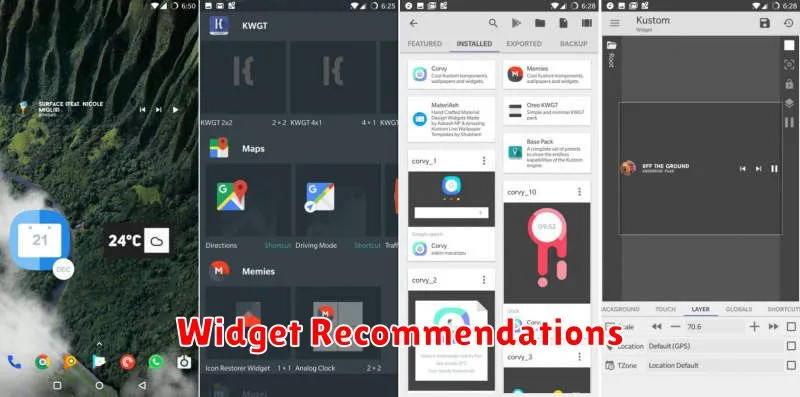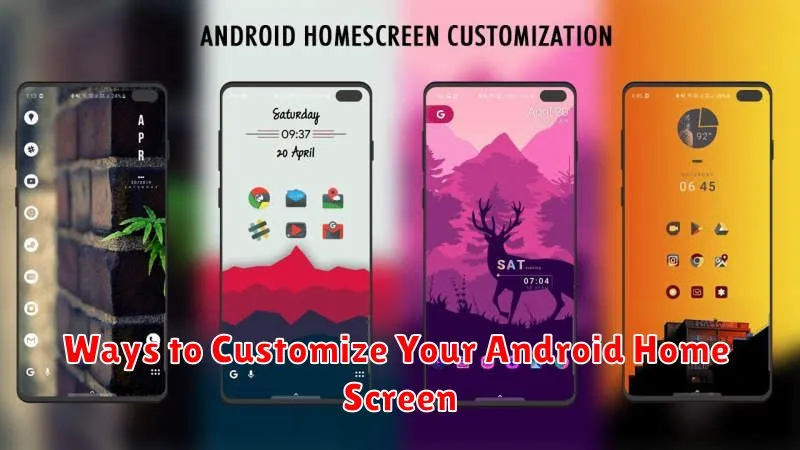Your Android home screen is the first thing you see when you unlock your phone. It’s the gateway to all your apps and information. Are you tired of the same old look? Do you want to customize your Android experience? This article explores numerous ways to customize your Android home screen, transforming it from a standard interface into a personalized reflection of your style and needs. We’ll cover everything from simple tweaks like changing your wallpaper and adding widgets, to more advanced options like using custom launchers and icon packs. Whether you’re looking for a minimalist setup or a vibrant, feature-rich display, you’ll find the perfect customization solution here.
Learn how to truly make your Android device your own. Discover the power of home screen customization and unlock the potential of your Android phone. This guide provides step-by-step instructions and helpful tips to achieve a variety of customized looks. Explore the many ways to customize your Android home screen and create an interface that is both functional and aesthetically pleasing. From organizing your apps with folders and shortcuts to implementing dynamic wallpapers and unique widgets, we’ll empower you to take full control of your Android home screen.
Choosing a Custom Launcher
One of the most significant ways to personalize your Android home screen is by installing a custom launcher. A launcher essentially replaces the default home screen interface provided by your manufacturer.
There are numerous launchers available on the Google Play Store, each offering unique features and customization options. Some prioritize aesthetics with sleek animations and icon packs, while others focus on functionality, offering enhanced features like gesture controls and custom widgets.
When selecting a launcher, consider factors like performance, customizability, and features. Research different options, read reviews, and perhaps try out a few before settling on one that best suits your preferences and needs.
Widget Recommendations

Widgets offer a powerful way to personalize your home screen and access information quickly. Choosing the right widgets can significantly improve your Android experience. Here are a few recommendations categorized by function:
Productivity
For enhanced productivity, consider calendar widgets for at-a-glance scheduling, note-taking widgets for quick reminders, and to-do list widgets for efficient task management.
Information
Stay informed with weather widgets providing real-time updates, news widgets delivering headlines, and traffic widgets for commute planning. Consider widgets that offer customizable information displays to minimize clutter.
Entertainment
Enjoy convenient access to entertainment with music player widgets, podcast widgets, and book reader widgets. These can enrich your downtime directly from your home screen.
Icon Pack and Font Styling
Icon packs offer a simple way to dramatically alter the aesthetics of your home screen. They provide a cohesive set of alternate icons for your apps, giving your device a fresh, unified look. Numerous icon packs are available on the Google Play Store, ranging from minimalist designs to vibrant and playful themes. Choosing an icon pack that aligns with your personal style can significantly enhance your Android experience.
Beyond iconography, customizing the system font can further personalize your device. While not all Android launchers support font changes directly, many offer this feature. Some manufacturers even include font customization options within their system settings. Experimenting with different fonts allows you to refine the overall look and feel of your home screen, adding a subtle yet distinctive touch.
Gesture Navigation Tweaks
Android offers robust customization options for gesture navigation, allowing you to tailor the experience to your preferences. Sensitivity adjustments can fine-tune how responsive the back gesture is, preventing accidental triggers. You can also modify the back gesture’s reach, dictating how far from the screen’s edge it registers a back action.
Furthermore, some Android versions and manufacturers offer additional tweaks like hiding the navigation bar for a truly immersive experience, often accompanied by options to adjust the sensitivity of the pill-shaped indicator. These options provide greater control over screen real estate and the overall feel of navigating your device.
Setting Dynamic Wallpapers
Dynamic wallpapers offer a visually appealing way to personalize your Android home screen. These wallpapers subtly shift and change over time, adding an element of dynamism to your device’s interface.
Accessing dynamic wallpapers usually involves navigating to your device’s wallpaper settings. The specific steps may vary slightly depending on your Android version and device manufacturer. Generally, a long press on an empty space on your home screen will bring up the home screen customization options, where you can find wallpaper settings.
Once in the wallpaper section, look for the “Dynamic” category or a similarly named option. Choose from the available dynamic wallpaper selections. Preview a wallpaper before applying it to see how it animates and changes.
Using Themes and Dark Mode
Themes offer a comprehensive way to personalize your Android home screen. They can alter app icons, wallpapers, widgets, and even system sounds. Many manufacturers provide pre-installed themes, and numerous options are available for download through app stores.
Dark Mode is another effective customization feature. It inverts the typical light background and dark text display to a dark background with light text. This can reduce eye strain, especially in low-light conditions, and potentially conserve battery life on devices with OLED screens.
Most Android devices allow you to activate Dark Mode through the display settings. Some themes may also incorporate a dark mode option as part of their overall design.
Creating Folder Shortcuts
Folder shortcuts offer a convenient way to declutter your home screen while keeping frequently used apps readily accessible. This feature allows you to group similar applications together into a single icon, simplifying navigation.
To create a folder, long-press on an app icon. Drag it onto another app icon you wish to group it with. This will create a new folder containing both apps. You can then rename the folder to something descriptive.
To add more apps to the folder, simply drag them onto the folder icon. You can also remove apps from the folder by dragging them out.
Automating Layout Changes
Beyond manual customization, consider automating layout changes based on specific triggers. This can enhance your home screen’s functionality and adapt it to your changing needs throughout the day.
Tasker and similar automation apps allow you to define profiles based on time, location, or connected devices. These profiles can then trigger actions that modify your home screen layout, such as switching to a work-focused layout during business hours or activating a minimalist setup at night.
Launchers like Nova Launcher also provide some built-in automation capabilities, allowing for simplified automation of specific layout adjustments without needing a separate automation app.

